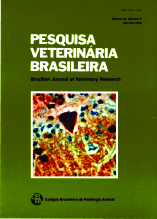 |
|
|
|
Year 2002 - Volume 22, Number 2
|

|
Clinical and pathological aspects of Sida carpinifolia poisoning in goats in Rio Grande do Sul, 22(2):51-57
|
ABSTRACT.- Colodel E.M., Driemeier D., Loretti A.P., Gimeno E.J., Traverso S.D., Seitz A.L. & Zlotowski P. 2002. [Clinical and pathological aspects of Sida carpinifolia poisoning in goats in Rio Grande do Sul.] Aspectos clínicos e patológicos da intoxicação por Sida carpinifolia (Malvaceae) em caprinos no Rio Grande do Sul. Pesquisa Veterinária Brasileira 22(2):51-57. Setor de Patologia Veterinária, Depto Patologia Clínica Veterinária, Faculdade de Veterinária, Universidade Federal do Rio Grande do Sul, Av. Bento Gonçalves 9090, Cx. Postal 15094, Porto Alegre, RS 91540-000, Brazil.
This report includes the clinical and pathological studies of a lysosomal storage disease which spontaneously occurred in three flocs of goats e after consumption of Sida carpinifolia, the predominant plant in the paddocks where the animals were grazing. In the outbreaks a total of 25 out of 51 animals were affected. Post-mortem examination was performed on 11 goats. The disease was experimentally induced by dosing goats with Sida carpinifolia. The plant was administered in natura or dried to 3 animals. No clinical or pathological changes were observed in one goat dosed with Sida rhombifolia ad libidum during 40 days. Clinical signs of the poisoning were ataxia, hypermetria, muscle tremors in the head and neck and disorders of deglutition. The clinical signs were exacerbated by movement. After the surviving animals had been moved to other pastures and stopped eating the plant, clinical signs were still observed during 24 months. At necropsy, no significant gross lesions were observed. Microscopic lesions included various degrees of vacuolization in the cytoplasm of neurons and glial cells. Similar lesions were observed in the acinar pancreatic cells, hepatocytes, proximal convoluted tubular cells, follicular epithelial cells of the thyroid gland and macrophages oflymph nodes. In the surviving animals, mild neuronal cytoplasmic vacuolization was observed, and few cells were eosinophilic and shrunken. In these cases neurons, especially Purkinje cells, had disappeared. Through the histochemical study of the cerebellar sections, the lysosomal storage disease was characterized as an alpha-mannosidosis. The vacuoles within the Purkinje cells strongly reacted with lectins of Concanavalia ensiformis, Triticum vulgaris and succinylated Triticum vulgaris. The pattern observed in this investigation is similar to those seen in other poisonings by swainsonine-containing plants. |
| |
|
|
| |
|
 |